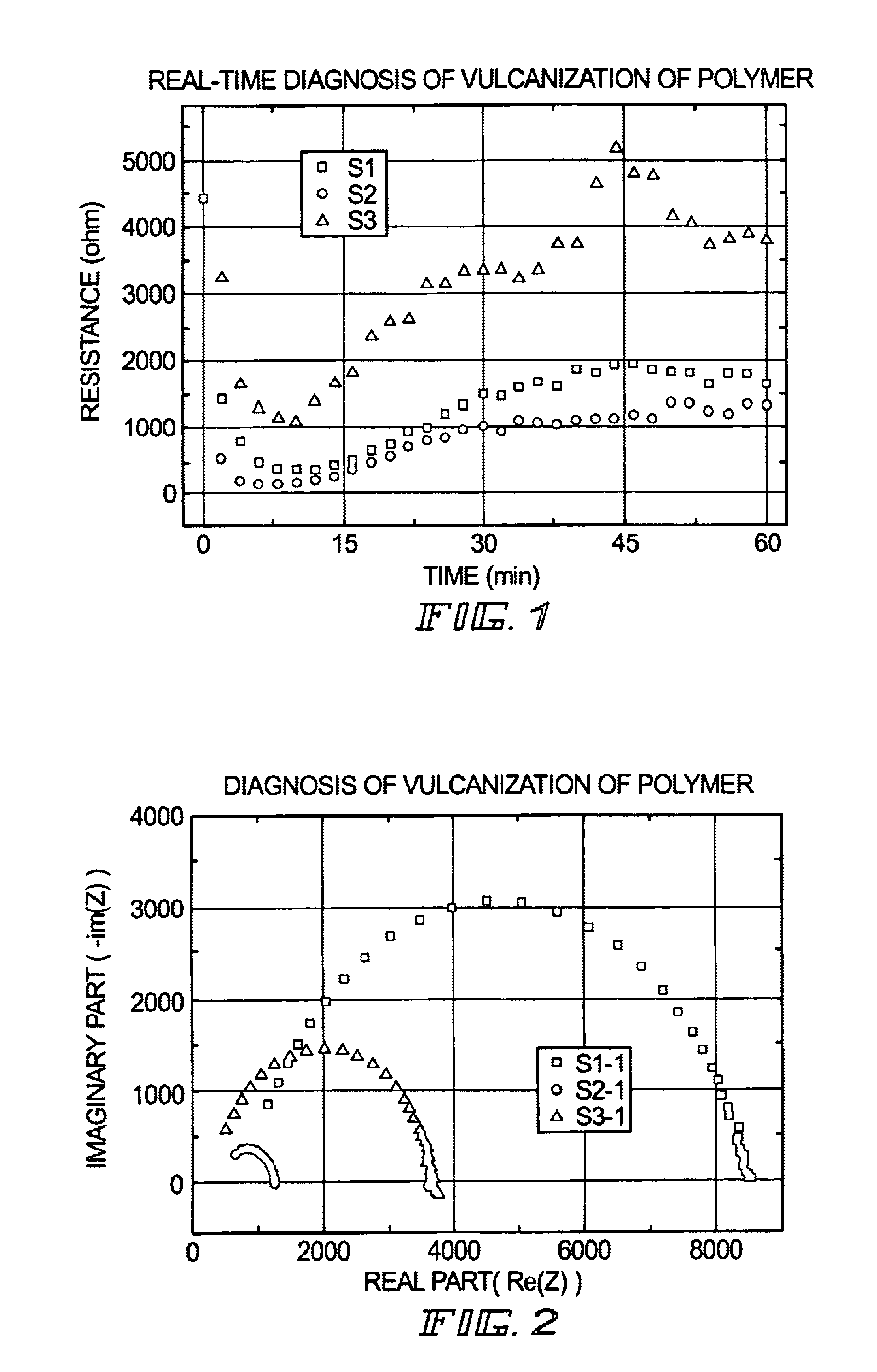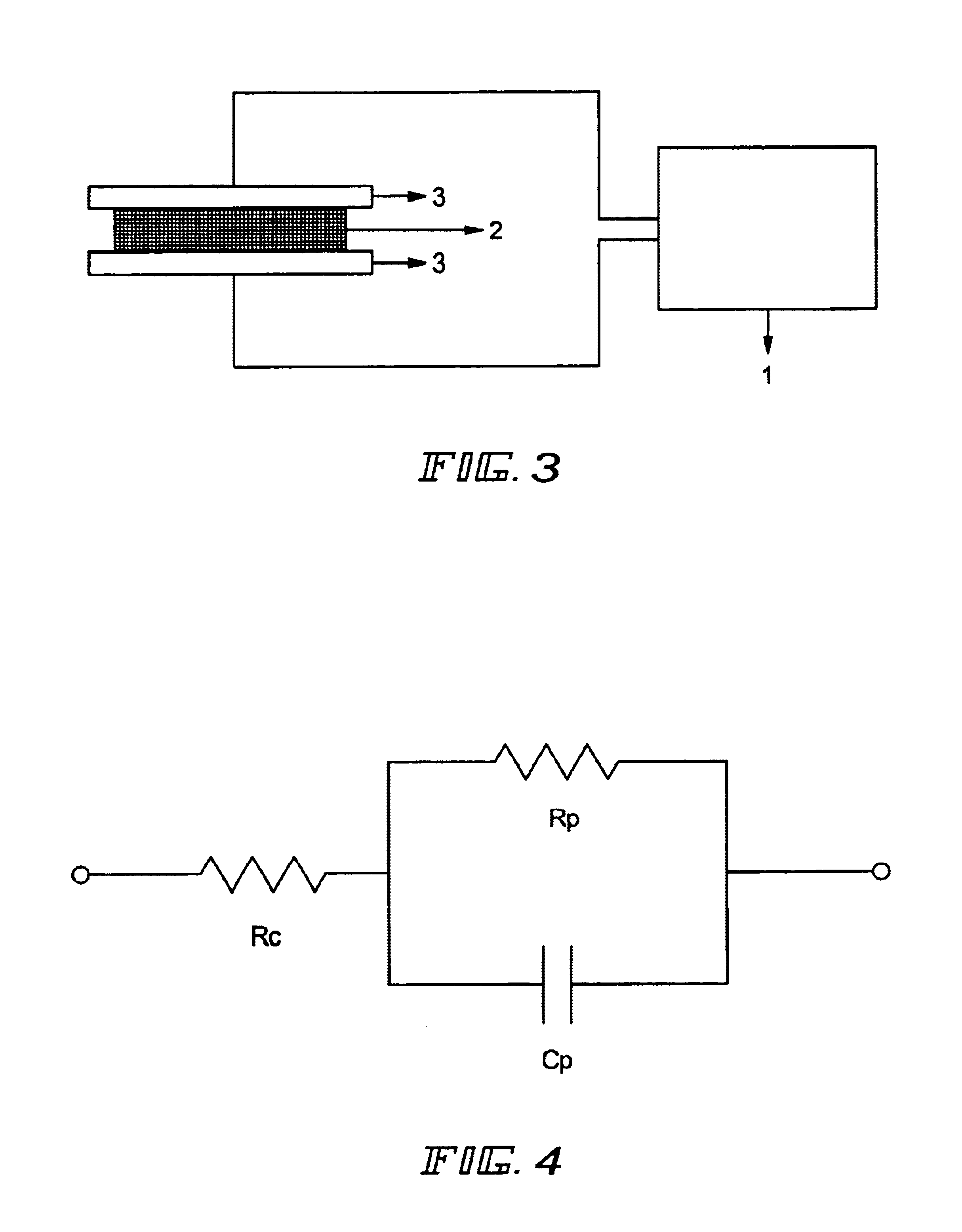Method for determining optimal degree of vulcanization and optimal content of constituent ingredient of composition for vulcanization in real time by impedance measurement and analysis
- Summary
- Abstract
- Description
- Claims
- Application Information
AI Technical Summary
Benefits of technology
Problems solved by technology
Method used
Image
Examples
examples 1 , 2 and 3
EXAMPLES 1, 2 and 3
[0018]The samples used in measuring the variations of the properties of rubber during the crosslinking process were prepared with the compositions as listed in Table 1 according to a known method prior to the crosslinking process. The synthetic rubber as used in the test was styrene butadiene rubber (SBR) supplied from Korea Kumho Petrochemical Co., Ltd. The samples in Examples 1, 2 and 3 were different from one another in the content of sulfur and vulcanization accelerating agent in the rubber composition for vulcanization.
[0019]
TABLE 1Example123SampleS1S2S3Synthetic rubber137.5137.5137.5Carbon black68.7568.7568.75Zinc oxide3.03.03.0Stearic acid1.01.01.0Sulfur1.02.03.0Vulcanization accelerating agent1.02.03.0
examples 4 , 5 and 6
EXAMPLES 4, 5 and 6
[0020]The samples used in measuring the properties of the rubber after the completion of vulcanization were prepared with the compositions as listed in Table 2 according to a known method prior to the crosslinking process. Then, the vulcanization time was varied depending on the content of sulfur and vulcanization accelerating agent in the rubber composition for vulcanization. The vulcanization time based on the content was measured using a known rheometer method. The synthetic rubber as used in the test was SBR supplied from Korea Kumho Petrochemical Co., Ltd. The samples in Examples 4, 5 and 6 were different from one another in the content of sulfur and vulcanization accelerating agent in the rubber composition for vulcanization and the vulcanization time.
[0021]
TABLE 2Example123SampleS1-1S2-1S3-1Synthetic rubber137.5137.5137.5Carbon black68.7568.7568.75Zinc oxide3.03.03.0Stearic acid1.01.01.0Sulfur1.02.03.0Vulcanization accelerating agent1.02.03.0Vulcanization t...
example 7
[0022]Now, a specific example of measuring the variations of the properties of the rubber during the crosslinking process will be described in detail. The following description will be given to the real-time property measurement for samples S1, S2 and S3 of Examples 1, 2 and 3, respectively, which are different from one another in the content of sulfur and vulcanization accelerating agent in the rubber composition for vulcanization.
[0023](a) The measurement of impedance was performed to evaluate the crosslink degree of the vulcanized samples in real time during the vulcanization process. The impedance spectrum was measured in an adequate frequency range (10 kHz to 1 Hz) for determining the parameters of an equivalent circuit model used in the spectrum analysis. A battery diagnosis system (Powergraphy™, model name: BPS 1000FL) supplied from Korea Kumho Petrochemical Co., Ltd. was used in the impedance measurement. For the real-time impedance measurement during vulcanization at a high...
PUM
| Property | Measurement | Unit |
|---|---|---|
| Frequency | aaaaa | aaaaa |
| Frequency | aaaaa | aaaaa |
| Temperature | aaaaa | aaaaa |
Abstract
Description
Claims
Application Information
 Login to View More
Login to View More - R&D
- Intellectual Property
- Life Sciences
- Materials
- Tech Scout
- Unparalleled Data Quality
- Higher Quality Content
- 60% Fewer Hallucinations
Browse by: Latest US Patents, China's latest patents, Technical Efficacy Thesaurus, Application Domain, Technology Topic, Popular Technical Reports.
© 2025 PatSnap. All rights reserved.Legal|Privacy policy|Modern Slavery Act Transparency Statement|Sitemap|About US| Contact US: help@patsnap.com


